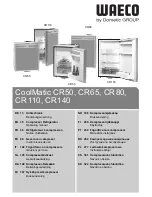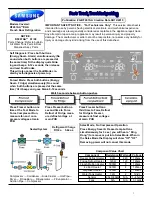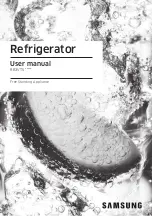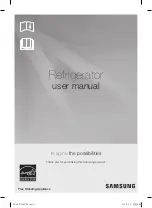
3
with the appliance.
– WARNING: Keep ventilation openings, in the appliance enclosure or in the built-in structure, clear of obstruction.
– WARNING: Do not use mechanical devices or other means to accelerate the defrosting process, other than those
recommended by the manufacturer.
– WARNING: Do not damage the refrigerant circuit.
– WARNING: Do not use electrical appliances inside the food storage compartments of the appliance, unless they are of
the type recommended by the manufacturer.
– WARNING: Refrigerating appliances – in particular a refrigerator-freezer Type I – might not operate consistently
(possibility of defrosting of contents or temperature becoming too warm in the frozen food compartment) when sited for an
extended period of time below the cold end of the range of temperatures for which the refrigerating appliance is designed;
– WARNING: The necessity that, for doors or lids fitted with locks and keys, the keys be kept out of the reach of children
and not in the vicinity of the refrigerating appliance, in order to prevent children from being locked inside.
– WARNING: The refrigerant used in your appliance and insulation materials requires special disposal procedures.
– WARNING: When positioning the appliance, ensure the supply cord is not trapped or damaged.
– WARNING: Do not locate multiple portable socket-outlets or portable power supplies at the rear of the appliance.
Children aged from 3 to 8 years are allowed to load and unload refrigerating appliances.
To avoid contamination of food, please respect the following instructions:
– Opening the door for long periods can cause a significant increase of the temperature in the
compartments of the appliance.
–Clean regularly surfaces that can come in contact with food and accessible drainage systems.
– Clean water tanks if they have not been used for 48 h; flush the water system connected to a water supply if water has
not been drawn for 5 days.
– Store raw meat and fish in suitable containers in the refrigerator, so that it is not in contact with or
drip onto other food.
– Two-star frozen-food compartments are suitable for storing pre-frozen food, storing or making ice-
cream and making ice cubes.
– One-, two- and three-star compartments are not suitable for the freezing of fresh food.
– If the refrigerating appliance is left empty for long periods, switch off, defrost, clean, dry, and leave the door open to
prevent mould developing within the appliance.
Electrical Connection
WARNING
This appliance should be properly grounded for your safety. The power cord of this appliance is equipped with a
three-prong plug which mates with the standard three prong wall outlets to minimize the possibility of electrical shock.
Do not, under any circumstances, cut or remove the third ground prong from the power cord supplied.
This refrigerator appliance requires a standard 220-240VAC 50/60Hz electrical outlet with three-prong ground.
This refrigerator appliance is not designed to be used with an inverter.
The cord should be secured behind the appliance and not left exposed or dangling to prevent accidental injury.
Never unplug the refrigerator by pulling the power cord. Always grip the plug firmly and pull straight out from the
receptacle.
Do not use an extension cord with this appliance. If the power cord is too short, have a qualified electrician or service
technician install an outlet near the appliance. Use of an extension cord can negatively affect the performance of the unit.
Improper use of the grounded plug can result in the risk of electrical shock. If the power cord is damaged, have it
replaced by an authorized service center.
Climate Range
The information about the climate range of the appliance is provided on the rating plate. It indicates at which ambient
temperature (that is, room temperature, in which the appliance is working) the operation of the appliance is optimal
(proper).
Climate range
Permissible ambient temperature
SN
from +10°C to +32°C
N
from +16°C to +32°C
ST
from +16°C to +38°C
T
from +16°C to +43°C
Note
:
Given the limit values of the ambient temperature range for the climate classes for which the refrigerating appliance
is designed and the fact that the internal temperatures could be affected by such factors as location of the refrigerating
appliance, ambient temperature and the frequency of door opening, the setting of any temperature control device might
have to be varied to allow for these factors, if appropriate.
If the power cable is damaged, it must be replaced by the manufacturer, its service agent or similarly qualified persons in
order to avoid a hazard.
Locks
If your Refrigerator is fitted with a lock, keep the key out of reach and not in the vicinity of the appliance to prevent children
being entrapped. When disposing of an old Refrigerator, break off any old locks or latches as a safeguard.
Freon-free
The freon-free refrigerant (R600a) and the foaming insulation material (cyclopentane) that is environmentally friendly are
used for the refrigerator, causing no damage to the ozone layer and having a very small impact on the global warming.
R600a is flammable, and sealed in a refrigeration system, without leakage during normal use. But, in case of refrigerant
leakage due to the refrigerant circuit being damaged, be sure to keep the appliance away from open flames and open the
windows for ventilation as quickly as possible.




































